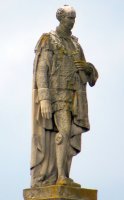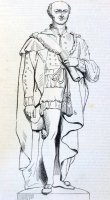Grey's Monument, Newcastle, 133 ft high, is one of the earlier column monuments in the country, and is the work of the sculptor E. H. Baily, who later carved Nelson for the monument in London.
Grey's Monument, Newcastle, by E.H.Baily.
The stone statue of Earl Grey [Grey's Monument], at the crossing of Grey Street and Grainger Street, Newcastle, stands on a tall column. Statues on such columns are something of a rarity, and even London has just a couple in the centre. The figure stands with one hand against his chest, holding a rolled up scroll; his other hangs loose. He is dressed not in early 19th Century contemporary clothing, but his robes of state: a high collar, chain of office, tunic with a tie and long tassels at the front, over leggings or bare legs, and a cloak over all, swept back on the left side as we look at the statue. Grey's best feature is his head, with high, curved forehead and ascetic face.
Grey's Monument, with Doric column.
The statue is made of two roughly equally sized blocks; the joint can be clearly seen, due to a bit of erosion and mending; the head is also separate after WW2 damage, and the left hand and part of the cloak replaced (the hand hangs loose rather than being partially closed as it was originally - see 1838 sketch below). The figure does not stand directly on the column, but is raised on two steps above a square plinth, with a door in it and a railed viewing platform. Below this is the column proper, Doric with a small capital, bearing carved wreaths, and then the fluted, circular shaft, almost 12ft in diameter, of masonry blocks not greatly larger than the blocks in the surrounding buildings, and of the same characteristic Newcastle sandstone. No base to the column as it is Doric, but it stands on a square plinth. The monument as a whole was announced as 133 ft high to the top of the statue's head when it was erected; modern accounts give slightly different measurements. Inside the column is the staircase, 164 steps of it, to the viewing platform which forms the abacus of the capital.
Contempory sketch of the statue when first erected.
The monument was put up in 1837-38, so a few years earlier than Nelson's Column in London (see this page), and while Earl Grey was still alive. As well as the man, who was Prime Minister from 1830-34, it also commemorated his government’s Reform Act of 1832, which extended the right to vote somewhat. It was under Grey that slavery was abolished across the British Empire. The eponymous tea is named after him, and he is also notable, along with his wife Mary Ponsonby, for having 16 children.
The sculptor was Edward Hodges Baily, who went on to produce Nelson for his column, and had a long, successful career mainly based around portrait sculpture, along with a smaller output of female nudes and other ideal subjects which were considered by some critics as his best work. The column on which Earl Grey stands was designed by a local architectural partnership, John and Benjamin Green of Newcastle, father and son. Among their other work in the city is the Theatre Royal, Grey Street, and the main rail station.
Also noted on these pages in Newcastle: Joseph Cowen statue, Westgate Road


